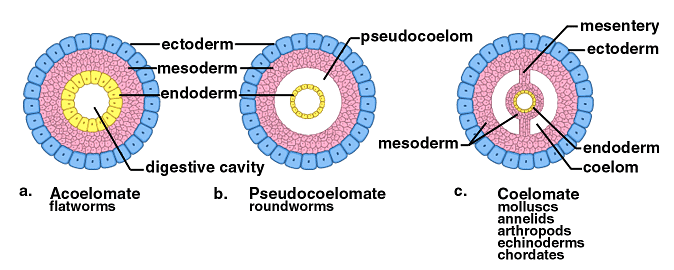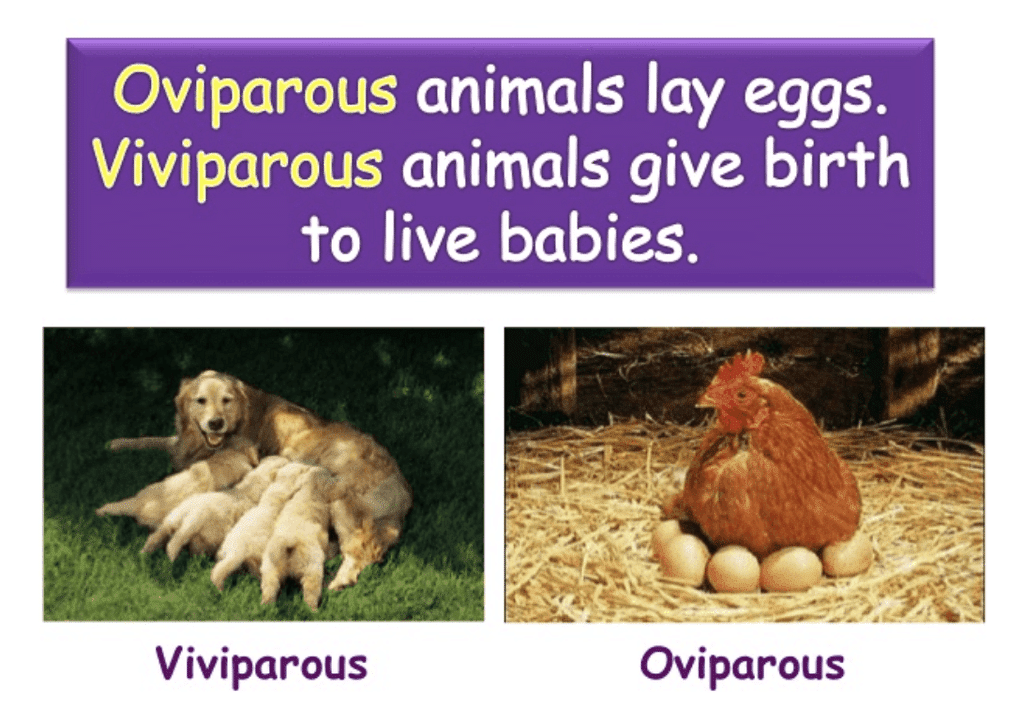NCERT Solutions Class 11 Biology Chapter 4 - Animal Kingdom
Q1: What are the difficulties that you would face in classification of animals, if common fundamental features are not taken into account?
Ans: For classifying living organisms, fundamental characteristics are used.
without considering these key features, the classification of animals would become quite confusing.
(i) Animals with different levels of organization might end up in the same group. For instance, sponges and cnidarians, which have cellular and tissue-level organization, respectively, could be grouped together.
(ii) Animals with different types of germ layers could be classified together, such as diploblastic cnidarians and triploblastic Platyhelminthes.
(iii) Animals with varying body symmetries might be placed in the same group, like coelenterates with radial symmetry and Platyhelminthes with bilateral symmetry.
Q2: If you are given a specimen, what are the steps that you would follow to classify it?
Ans: There is a certain common fundamental feature that helps in the classification of living organisms. The features that can be used in classification are as follows:
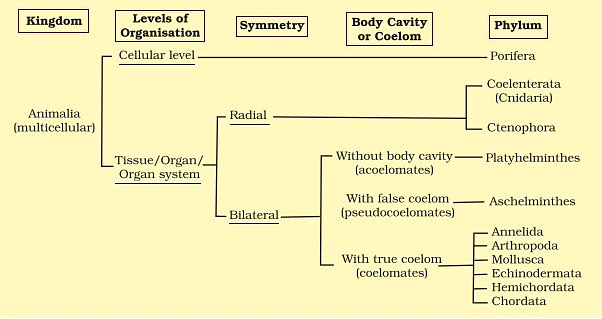
On the basis of the above features, we can easily classify a specimen into its respective category.
- Examine the external morphology of the specimen: Observe the external features of the specimen such as its size, shape, color, texture, etc.
- Identify the body plan of the specimen: Based on the symmetry of the specimen, you can classify it as either radially symmetrical or bilaterally symmetrical.
- Observe the internal structures of the specimen: Make a dissection of the specimen and observe its internal structures such as the digestive, respiratory, nervous, and reproductive systems.
- Identify the type of circulatory system: Observe the circulatory system of the specimen and identify whether it is an open or closed circulatory system.
- Identify the type of excretory system: Observe the excretory system of the specimen and identify whether it is a protonephridial or metanephridial excretory system.
- Determine the type of reproductive system: Observe the reproductive system of the specimen and determine whether it is asexual or sexual.
- Compare the characteristics of the specimen with known groups: Compare the characteristics of the specimen with the characteristics of known groups in the animal kingdom and determine the most likely group to which the specimen belongs.
- Confirm the classification: Finally, confirm the classification of the specimen by comparing it with additional specimens and consulting taxonomic keys and reference materials.
Q3: How useful is the study of the nature of body cavity and coelom in the classification of animals?
Ans:
- Coelom is a fluid-filled space between the body wall and the digestive tract. The presence or absence of a body cavity or coelom plays a very important role in the classification of animals.
- Animals that possess a fluid-filled cavity between the body wall and digestive tract are known as coelomates.
- Annelids, mollusks, arthropods, echinoderms, and chordates are examples of coelomates.
 Coelom
Coelom - On the other hand, the animals in which the body cavity is not lined by mesoderm are known as pseudocoelomates.
- In such animals, mesoderm is scattered in between ectoderm and endoderm. Aschelminthes is an example of pseudocoelomates.
- In certain animals, the body cavity is absent. They are known as acoelomates.
- An example of acoelomates is Platyhelminthes.
Q4: Distinguish between intracellular and extracellular digestion?
Ans:
Q5: What is the difference between direct and indirect development?
Ans:
Q6: What are the peculiar features that you find in parasitic Platyhelminthes?
Ans: Taenia (Tapeworm) and Fasciola (liver fluke) are examples of parasitic Platyhelminthes.
 Platyhelminthes
Platyhelminthes
Peculiar features in parasitic Platyhelminthes are as follows:
- They have dorsoventrally flattened bodies and bear hooks and suckers to get attached inside the body of the host.
- Their body is covered with thick tegument, which protects them from the action of the digestive juices of the host.
- The tegument also helps in absorbing nutrients from the host’s body.
Q7: What are the reasons that you can think of for the arthropods to constitute the largest group of the animal kingdom?
Ans: The phylum, Arthropoda, consists of more than two-thirds of the animal species on earth.
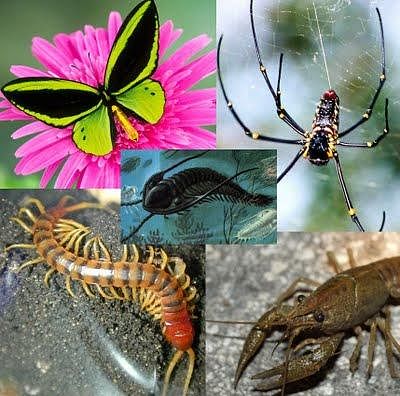 Phylum Arthropoda
Phylum Arthropoda
The reasons for the success of arthropods are as follows:
- Jointed appendages: Jointed legs that allow more mobility on land Hard exoskeleton made of chitin that protects the body.
- Exoskeleton: The hard exoskeleton also reduces water loss from the body of arthropods making them more adapted to terrestrial conditions.
- Segmented body plan: The body of arthropods is divided into segments, which allows for specialization of body parts and functions. This segmentation also allows for a high degree of flexibility and mobility.
- Highly developed sensory organs: Arthropods have highly developed sensory organs, such as compound eyes, antennae, and tactile hairs, which enable them to detect and respond to environmental cues.
- Efficient respiratory system: Arthropods have an efficient respiratory system, which allows for the exchange of gases even in small body sizes. Many arthropods have tracheal systems or gills for respiration.
Q8: Water vascular system is the characteristic of which group of the following:
(a) Porifera
(b) Ctenophora
(c) Echinodermata
(d) Chordata
Ans: Water vascular system is a characteristic feature of the phylum, Echinodermata.
 Echinodermata
Echinodermata
The water vascular system is a characteristic of the phylum Echinodermata. The water vascular system is a unique hydraulic system that is used for locomotion, feeding, and gas exchange. This system consists of a network of fluid-filled canals and specialized structures called tube feet, which are used for movement and feeding.
Q9: “All vertebrates are chordates but all chordates are not vertebrates”. Justify the statement.
Ans: The statement "All vertebrates are chordates but all chordates are not vertebrates" can be justified by understanding the definitions and characteristics of chordates and vertebrates.
- Chordates are a phylum of animals that possess certain distinct features during their development or at some point in their life cycle. These features include a notochord (a flexible rod-like structure), a dorsal hollow nerve cord, pharyngeal slits or pouches, and a post-anal tail.
 Chordata
Chordata
- On the other hand, vertebrates are a subphylum of chordates that possess an additional characteristic of having a vertebral column or backbone, which is made up of individual vertebrae. Vertebrates are further classified into five classes: fishes, amphibians, reptiles, birds, and mammals.
- Based on these definitions and characteristics, we can say that all vertebrates are chordates because they possess the features of chordates, including the notochord, dorsal hollow nerve cord, pharyngeal slits or pouches, and post-anal tail. However, not all chordates are vertebrates because there are some chordates that do not possess a vertebral column.
- For example, the subphylum Urochordata, which includes tunicates or sea squirts, and the subphylum Cephalochordata, which includes lancelets or amphioxus, are chordates but do not possess a vertebral column.
In summary, while all vertebrates are chordates because they possess the characteristics of chordates, not all chordates are vertebrates because some chordates do not possess a vertebral column.
Q10: How important is the presence of air bladder in Pisces?
Ans: The presence of an air bladder, also known as a swim bladder or gas bladder, in Pisces, which refers to the class of fish, is highly significant for their survival and adaptation to their aquatic environment.
- The air bladder serves as a hydrostatic organ that helps Pisces to regulate their buoyancy and maintain their position in the water column. By controlling the amount of gas within the air bladder, fish can adjust their overall density, allowing them to ascend, descend, or remain suspended at different depths in the water.
- The ability to control their buoyancy is crucial for various aspects of a fish's life, such as efficient swimming, predator avoidance, and prey capture. It also allows them to conserve energy by reducing the effort needed to maintain their position in the water column.
Q11: What are the modifications that are observed in birds that help them fly?
Ans: Birds have undergone many structural adaptations to suit their aerial life.
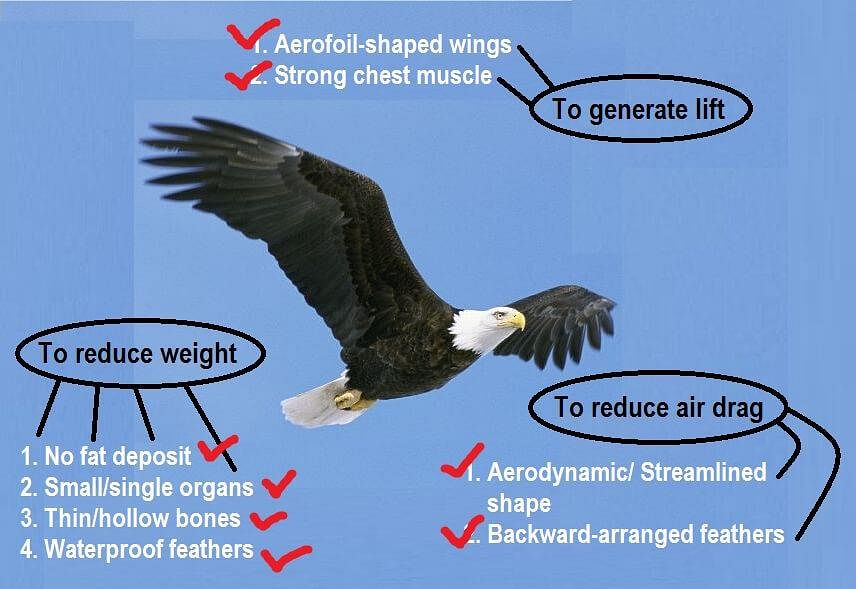 Bird Observation of Flying
Bird Observation of Flying
Some of these adaptations are as follows:
- Streamlined body for rapid and smooth movement.
- Covering of feathers for insulation.
- Forelimbs modified into wings and hind limbs used for walking, perching, and swimming.
- Presence of pneumatic bones to reduce weight.
- Presence of additional air sacs to supplement respiration.
Q12: Could the number of eggs or young ones produced by an oviparous and viviparous mother be equal? Why?
Ans:
- The numbers of eggs produced by an oviparous mother will be more than the young ones produced by a viviparous mother.
- This is because in oviparous animals, the development of young ones takes place outside the mother’s body.
- Their eggs are more prone to environmental conditions and predators.
 Difference between Oviparous and Viviparous animals
Difference between Oviparous and Viviparous animals - Therefore, to overcome the loss, more eggs are produced by mothers so that even under harsh environmental conditions, some eggs might be able to survive and produce young ones.
- On the other hand, in viviparous organisms, the development of young ones takes place in safe conditions inside the body of the mother. They are less exposed to environmental conditions and predators.
- Therefore, there are more chances of their survival and hence, less number of young ones is produced compared to the number of eggs.
Q13: Segmentation in the body is first observed in which of the following:
(a) Platyhelminthes
(b) Aschelminthes
(c) Annelida
(d) Arthropoda
Ans: The body segmentation first appeared in the phylum Annelida (annulus meaning little ring).
Q14: Match the following: 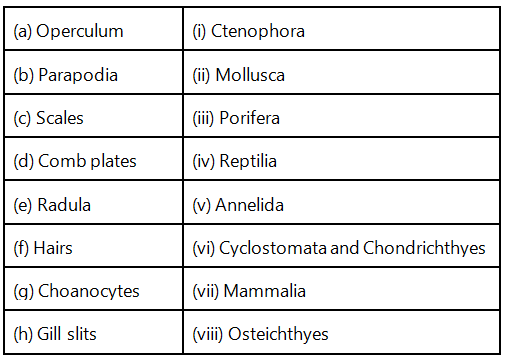
Ans:
Q15: Prepare a list of some animals that are found parasitic on human beings.
Ans:
|
182 videos|367 docs|152 tests
|
FAQs on NCERT Solutions Class 11 Biology Chapter 4 - Animal Kingdom
| 1. What are the main characteristics that classify animals in the Animal Kingdom? |  |
| 2. How are animals classified into different phyla in the Animal Kingdom? |  |
| 3. What is the difference between vertebrates and invertebrates in the Animal Kingdom? |  |
| 4. Can you explain the significance of biodiversity in the Animal Kingdom? |  |
| 5. What are some examples of adaptations in animals that help them survive in their environments? |  |

|
Explore Courses for NEET exam
|

|
